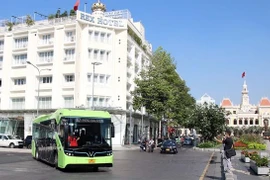Developing electric vehicles is an inevitable trend to achieveenvironmental objectives under the city’s green traffic development project,according to the department.
Tran Quang Lam, director of the department, said the city plans tobuild six BRT routes with a total length of about 100km.
Funded by the World Bank (WB), the green traffic developmentproject involves the construction of a 23km-long BRT main corridor. The corridorwill run from An Lac Intersection in Binh Tan district to Rach Chiec bridge inThu Duc city.
Over the past 10 years, the city has had buses that use compressednatural gas (CNG) accounting for about 20% of the total number of vehicles inoperation.
To meet its sustainable growth targets by 2030, it would benecessary to implement appropriate vehicles for the BRT route as well as thecity's public transportation system in general, he said.
The BRT No. 1 project initially planned to use CNG buses on theroute.
The department has consulted scientists and WB experts to adviseselecting vehicles for this project.
WB expert Shige Sakaki said electric buses have become a viableoption as they have been used in many countries.
Besides reducing noise and toxic emissions compared to dieselbuses, the operation and maintenance of electric buses are also cheaper.
However, developing electric buses still has some limitations suchas high production costs, and a lack of charging station infrastructure andmaintenance shops, according to the department.
The city has piloted two electric bus lines, using 12-seat minibuses, in districts 1 and 7 since 2017.
The first 29km-long electric bus route called D4 was launched inMarch, connecting the Vinhomes Grand Park Urban Area in Thu Duc city with the SaiGon bus station in district 1.
The city has also allowed the use of electric vehicles with fewerthan 15 seats in Can Gio district to take tourists to hotels and tourist sites.
In 2020, the city’s administration approved a 400 trillion VND (17.3billion USD) project to improve access to public transportation and limit theuse of personal vehicles over the next decade.
The focus will be on developing the bus network, includingenhancing inter-provincial connectivity.
Under the project, public transportation would meet 15% ofresidents’ travel demand by 2025 and 25% by 2030.
By 2025, the city targets having the bus system connect new urbanareas, industrial parks, satellite urban areas and passenger transport routes.
To improve bus services and increase ridership, the department isexpected to open public bidding for bus routes.
As many as 50-60 new routes are expected to start by 2025,increasing to around 75 by 2030, and the number of buses would double in thenext 10 years, he said.
Priority will be given to vehicles that use clean andenvironment-friendly fuels such as CNG, LPG and electricity.
The quality of human resources operating buses will be improvedand the management and operation of public transport systems will bemodernised.
By 2025, the bus network would be expanded from 126 routes with2,100 buses to 260 routes with 3,000 buses.
Every year, the city provides subsidies of 1 trillion VND (43million USD) to bus companies.
A new inter-provincial bus route connecting HCM City and theprovinces of Long An and Tien Giang officially opened on August 10./.




























